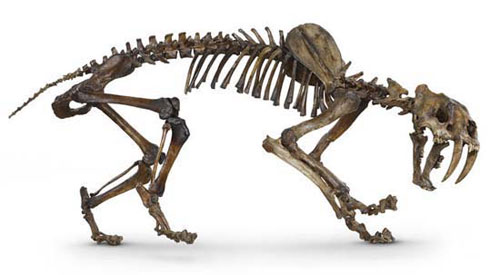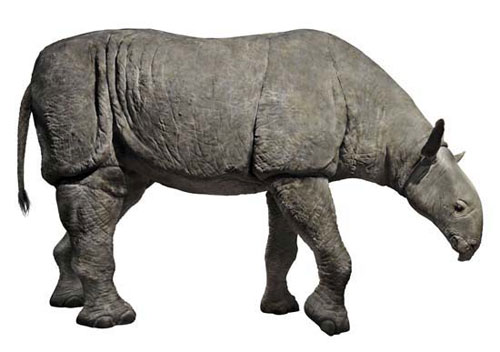10 exotic mammals
The American Institute of Science in San Francisco in California opened an exhibition of the largest, smallest and most amazing mammals in the evolutionary history of animals. In it, there are many strange species, but most are extinct.
1. Saber cat teeth

Saber cat teeth are not a cat but they possess sharp fangs like those of cats and are very long. In the Pleistocene (ice age), saber cat teeth are present throughout North America and continental Europe.
In California, archaeologists have found thousands of fossils of this species. According to experts, saber cat teeth can kill prey with their two sharp teeth. "He bit his stomach or swallows his prey, a deadly attack."
2. Huge rhinoceros

Giant rhinoceros is the largest mammal known on land. In its amount can be up to 20 tons, equivalent to 3-4 adult African elephants. This giant animal exists around 3,400 to 2,300 before and is distributed mainly in the forests of Central Asia today. Thanks to the long neck, they can reach large leaves to eat. Scientists believe it is the transformation from the last grassland that has made the giant rhino extinct.
3. The smallest mammal in history
"Batodonoides vanhouteni" is the smallest mammal species on Earth known but they were extinct 50 million years ago. They appear to resemble shrews but are as small as a fly. Its weight and 1 USD sheet are almost equal and can be placed on top of a pencil.

The smallest surviving mammal to this day is the bumblebee bat 3cm long and weighing 2 grams. Bumblebee bats were discovered in Thailand in 1974 but are in danger of extinction.
4. Honey bear

Bile bears live mainly in tropical forests in Central and South America. They live on trees and have very long tails. They eat honey and sleep on trees, using their long tails to roll up like a blanket. The bile's tongue is very small and fragile, helping them to get nectar or lick bile in honeycomb.
5. Whale crocodile

Whales are semi-aquatic mammals. Their ancestors have moved from the ground to the water and are the transition to keep four-legged animals. Obviously looking at this whale, no one wants to encounter it in the swamp.
This whale has a crocodile skin but its head is actually a whale. It possesses a strong set of jaws that can hold its prey under water. Paleontologists believe that this whale has a crocodile-like way of hunting: It will ambush and suddenly use large teeth to pin to its prey and sink it into the water until death.
6. "Tasmanian Devil"

The Tasmanian devil is the world's largest predator, living mainly in Australia, mainland China in ancient times. Now few can be found in Tasmania in Australia. Although they only have a pair of tall legs, look cute but are the ones that often bite the other mammals.
A 6 kg Tasmanian devil can still easily kill a badger weighing 30 kg. Unfortunately, in the past 10 years, their numbers have fallen by nearly half because of a deadly infectious disease that causes tumors to spread in their species.
7. Camel long neck

South American long-necked camels are the only camel with claws. It has camel body, but has a long neck like a giraffe, has a long nose like an elephant. They were extinct nearly 1 million years ago.
8. Platypus

Platypus is the oldest and most primitive mammal and dates back to 15 million years ago. According to their structure, this animal has evolved from reptiles. Platypus legs have membranes and there are thorns containing venom. Their venom is almost like a snake's venom, which can make the victim suffer and it takes months to cure it. Platypus lay eggs and hatched like birds, but the females reared their babies with milk.
9. Giant ground sloth

The ground lazy species is an ancient lazy species that has become extinct. They have no fangs, live on the ground and are related to lazy species today. The ground has sharp claws that can stand upright with 2 hind legs.
They are nearly 6 meters long and weigh 4 tons with the weight of an African elephant. Lazy ground is mammals, moving slowly and eating grass. Sharp claws help it to cling to the leafy branches to eat.
10. Monkey monkey

The proboscis monkey in Southeast Asia has a big, red nose. When they are happy, the nose will swell up or vibrate looking very strange. The monkey's nose is larger than the male's nose. The nose is also what helps chisel monkeys to attract mates. The longer the male nose monkey, the more admirable the female is. There are nasal male monkeys up to 18cm long. Each proboscis monkey group usually consists of 8-10 heads, distributed in a wide area about 2km.
Source: Sina
- Archaeological discovery of venomous mammals on hind legs
- Mammals contain toxins
- New mammals found in South America
- New discovery of the physique of mammals
- 1/3 of extinct mammals are rediscovered
- Animals switch diets when climate changes
- 200 years later, the largest terrestrial mammal could be cattle
- Dead dinosaurs, mammals
- 1/6 Mediterranean mammals are facing extinction
- 66 million years ago the new animals were the boss of this Earth
- Strange porcupine, long snout, colorful
- Great extinct Australian mammals
 Animal 'suffering' after hibernation
Animal 'suffering' after hibernation Why do goats climb well?
Why do goats climb well? Scientists were surprised to see chimpanzees eating turtles
Scientists were surprised to see chimpanzees eating turtles Giant catfish died deadly due to drought in Thailand
Giant catfish died deadly due to drought in Thailand